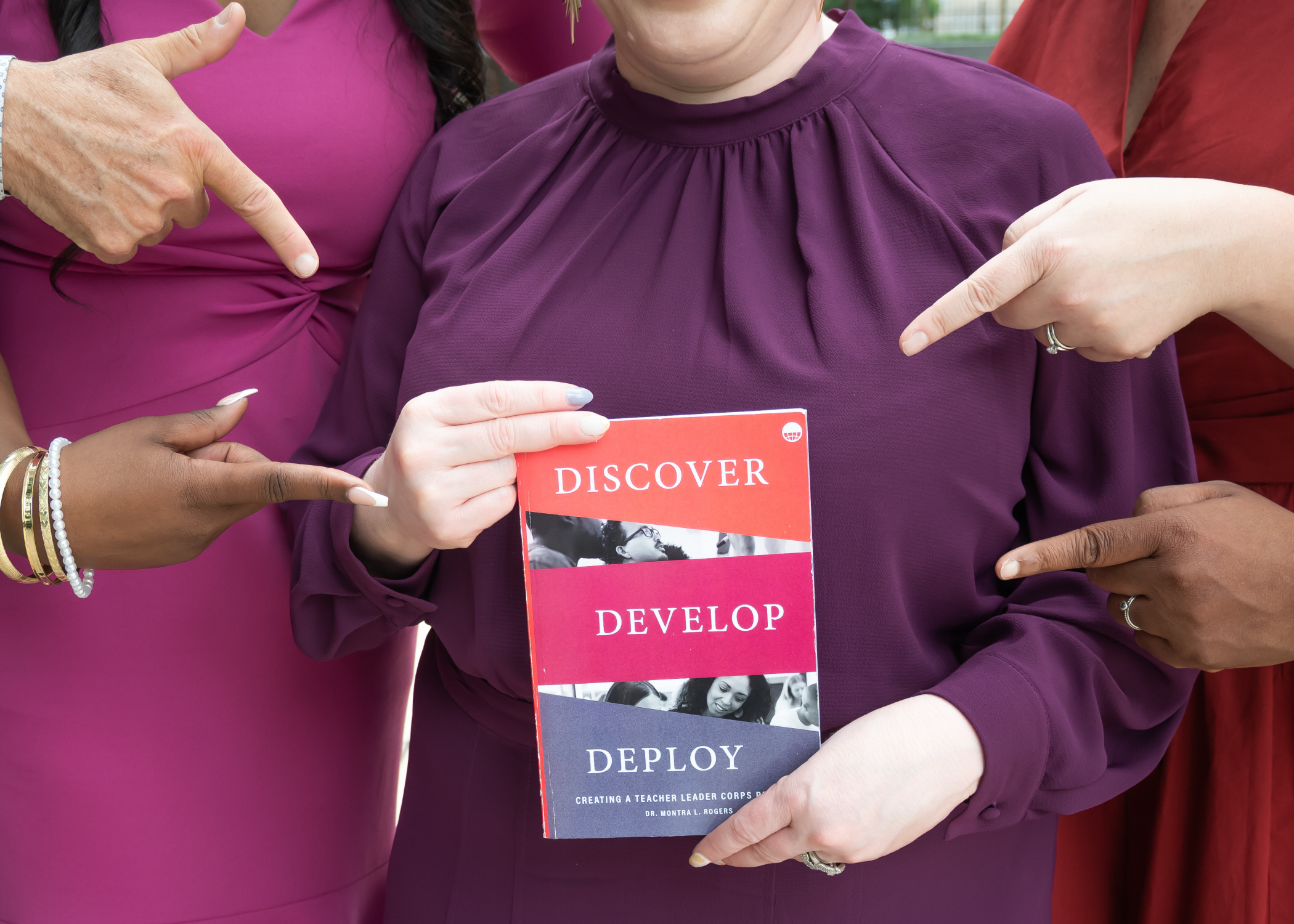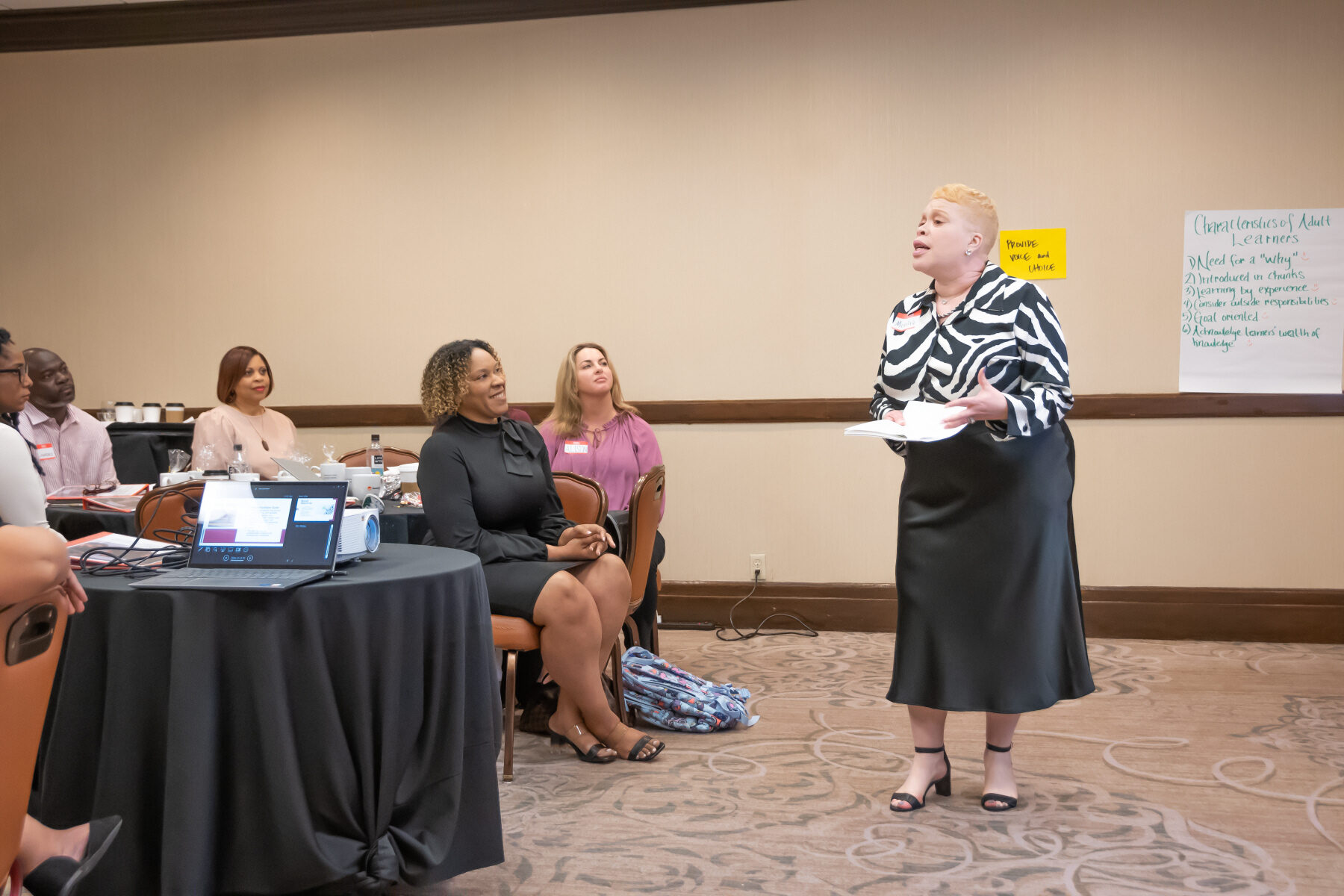
Developing long-lasting leaders in education has always been the goal of Dr. Montra L. Rogers. In her innovative and inspirational book, Discover Develop Deploy: Creating a Teacher Leader Corps Program, she overviews the journey that one district’s went through to develop a sustainable professional learning program. Throughout the book, readers learn a step-by-step framework to create personalized pathways to create their own Teacher Leader Corps program in a district and expand the capacity of their departments.
While she’s always been a leader in schools, Dr. Rogers now expands her capacity and shares her vision as a leader at Social Studies School Service as Director of Partnership and Instruction. We sat down with her to learn more about what inspired her to write the book, advice for readers, and how she knows her vision for Teacher Leader Corps programs has been actualized.
What inspired you to write the book?
In 2018, my colleagues and I presented a session at the National Council for the Social Studies (NCSS) Annual Conference in Chicago, titled “Discover, Develop, and Deploy: Creating a Teacher Leader Corps Program.” I was amazed by the amount of interest and questions posed.
Fast forward to February 2019 where Jason Ihlenfeld, Curriculum Specialist for Social Studies School Service, approached me at the Texas Social Studies Supervisors Spring Meeting. He mentioned that a number of educational leaders expressed interest in what was happening in my district. He also learned that other vendors and publishers who also partnered with my district discussed their experiences with the Teacher Leader Corps program. Comments like those and the interest was flattering, but I wasn’t totally sold. I likened the idea of writing a book aligned to my doctoral dissertation, but I had not recovered from the demands of that experience. Honestly, I enjoyed the writing process, but writing a dissertation was time-consuming.To this day, I still cannot explain how I pulled that off with the demands of working in a large urban school district. I questioned if I could do it again. Could I write an entire book?
Here is what changed my mind: I begin to see the impact of the program. Most notably a teacher leader from the program became the Director of Secondary Social Studies once I was promoted to the position of Officer of Curriculum. We were able to easily fill vacant instructional coaching and curriculum specialist positions with individuals who had served in our Teacher Leader Corps program. Teacher leaders who were coached by those instructional coaches were able to move into position of leadership. Most importantly, student achievement data was positively impacted by this program. The schools in which teacher leaders taught and those where instructional coaches who had been teacher leaders supported grew by at least ten points. I knew it was time to write a book.
What perspectives or beliefs have you challenged in this book?
Here is what I have challenged in this book: rethinking how we in education define leadership. How many organizations have leadership academies and departments, and the only pathway is towards school administration or central office positions that support school administrators? Where are the systematic programs that pour into teachers so they are able to grow and develop in ways that increase their belief in themselves and their ability to positively impact their students’ lives? Where are the programs whose aim is to address sustainability and retention? Where are the programs that respect a teacher’s decision to remain in the classroom or accept informal leadership positions such as mentor or department chairperson? Where are the programs that help develop teachers who wish to pursue a career in curriculum development or instructional coaching? We must acknowledge that leadership is a much broader concept.
I also challenge, or maybe remind us of all, that professional learning that is a one off, that lacks follow up and feedback, that is void of reflection is ineffective. We listen to the webinars and nod our heads from our home offices, but we have yet to change our ways of doing things. Another belief challenged in this book is the power of teacher efficacy. I shared an advanced copy of this book with a retired school administrator during the soft launch of the book. I was somewhat caught off-guard by her assertion. She questioned the impact of such a program. She wondered how participation in this program would yield the test results necessary to move a school forward. I listened closely because I wanted to understand.
Instead of defending this work, I posed questions to ensure that I understood her perspective. We discussed what happens once a teacher leaves a professional development training. We identified possible reasons why transfer might not happen, and both agreed that it is important for teachers to believe in their ability to implement newly learned strategies, to understand concepts and content before any transfer can take place. There is power in teacher efficacy. The final chapter of this work reveals why this is so.
What is one misconception about the book you would like to address?
One misconception I wish to address is that this book is only for social studies programs or that it is only a process that is used to develop teacher leaders. We used a case study approach and while the focus of this work is one district’s social studies program, this process is applicable for any content area, audience, and industry.
What part of the book was the most fun to write?
In education, we talk about beginning with the end in mind. Writing the conclusion of this book was the most fun to write because I had the opportunity to see the end. As a leader, it is your hope that you leave a legacy of leadership. I had the pleasure of conversing with the inaugural cohort of our Teacher Leader Corps program and these individuals continue to show me the promise of what is possible when actions are accompanied by intention and leadership is carried out with purpose. We framed our conversations around the concepts of leadership, practices or behaviors, and positions and/or roles. Kelly Mayes and Jessica Hunt both discussed the power of community in relation to the Teacher Leader Corps. Interestingly, all participants mentioned that they became more confident in their leadership skills, and this confidence gave them the agency needed to influence change at their campuses. They are the boots on the ground. This essentially helps to create a sustainable social studies program, something that is difficult to achieve in a large urban school district.

What advice would you give to someone just starting a Teacher Leader Corps?
The best advice I can give someone wanting to begin a program is to spend a lot of time on establishing and developing your why statement. This is the foundation of your entire program. We go into great detail in chapter one of Discover Develop Deploy. You have to identify a problem of practice or something within your sphere of influence that you wish to change. From there, it is important to write a vision and mission statement. The vision is what you are building to address the problem of practice and the mission is why what you are building is important.
Leaders should ask themselves:
- What is their role in this work?
- Will you help teachers develop their content knowledge?
- Will this address a concern in your origination?
These three pieces, an identified problem of practice, your vision, and mission statement, and your role in this work is your why statement. Stay with this until you get it right. Moving ahead without a clear why statement will result in a lack of focus and will impact your overall program development.
What, to you, is the most important characteristic of a dynamic teacher leader?
In Discover Develop Deploy, chapter four is titled “Discovering Hidden Talent,” where I recall two conversations I had with colleagues. In both conversations, my colleagues alluded to the fact that teacher leaders were those individuals who taught in thriving schools, who were more than likely were department chairpersons, and who were “smart.” While a Teacher Leader Corps program is an ideal place for a high-flying teacher, there is also a place for a teacher who serves students in our most challenging schools. It is a place for teachers who have yet to realize their potential. For me, the ideal candidate is willing to work. This person is committed to learning and has the desire to demonstrate this new knowledge. It reminds us that people want to be developed; they need to be developed.
How did you help others in your department or on your team own the program?
Others in our department own the program in a variety of ways. My previous supervisor owned the program when she realized how important it was for her to advocate and support our efforts. She was our biggest fan. Her wish was that leaders in other content areas would have established a program of their own. Members of the social studies team owned programs and projects. For example, one member served as liaison to Rice University’s Boniuk Institute, while another member of the team owned the facilitation of our book discussions. Other members of our team sought out, wrote, and submitted grants for funding. Everyone on the team owned our For-Teachers-By-Teachers Conference. Teacher leaders themselves were responsible for implementing the curriculum and recruiting their team members and others to come to social studies professional learning events.
Did your why develop or change over time?
It took about a month or two to develop our why. We went back and forth as we wanted to make sure it addressed our problem of practice. We wanted to get it right. Our why has not changed. The goal of the Teacher Leader Corps was always to create public intellectuals who are the gold standard for leadership and professionalism. Our role or responsibility in implementing this program is to:
- Provide opportunities for teacher leaders to lead at the campus and district levels, and
- Create programming that supports and builds capacity in areas such as content development, instructional practice, instructional coaching, the facilitation of professional development, and leadership.
This has not changed. What will change is the programs we employ to accomplish this goal. This is why it is so important to spend time here when developing the program.
What is that one moment when you knew that your vision for the program had been actualized?
I give a great attention to this in the first question. Writing the conclusion of this book made me realize just how much we were able to add value to the lives of our first cohort. In addition, we are in year six of the program and it is still thriving. It is important to note that I have not led this program in two years. This is how I know that the vision of the program had been actualized!
Order a copy of Discover Develop Deploy: Creating a Teacher Leader Corps Program by Dr. Montra L. Rogers
Using district priorities, narratives, talent, and potential, Dr. Montra Rogers works closely with stakeholders to plan and program for the implementation of Social Studies School Service resources as the company’s Director of Partnership and Instruction. She understands firsthand the power of viable partnerships. Montra appreciates new opportunities and experiences to include traveling, dining, and attending social/cultural events; this also includes volunteering in her local community. She is the eldest of five girls and mother to one son. Montra has an Ed.D. in Educational Leadership, an MLA in Liberal Arts, and a BA in History.
